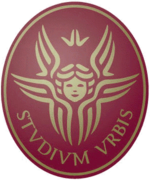University La Sapienza
| Sapienza – Università di Roma | |
 |
|
| Latin: Studium Urbis | |
| Motto | Il futuro è passato qui |
|---|---|
|
Motto in English
|
The future has passed here |
| Type | Public |
| Established | 1303 |
| Rector | Dr. Eugenio Gaudio |
|
Administrative staff
|
8,000 |
| Students | 112,564 |
| Location | Rome, Italy |
| Campus | Urban |
| Colors | |
| Athletics | CUS Roma |
| Affiliations | European Spatial Development Planning, Partnership of a European Group of Aeronautics and Space Universities, CINECA, Santander Network, Institutional Network of the Universities from the Capitals of Europe, Mediterranean Universities Union. |
| Website | uniroma1.it |
 |
|
| University rankings | |
|---|---|
| Global | |
| ARWU | 151-200 |
| Times | 251-300 |
| QS | 223 |
| Europe | |
| Times | =126 |
Coordinates: 41°54′12″N 12°30′57″E / 41.90333°N 12.51583°E
The Sapienza University of Rome, (Italian: Sapienza – Università di Roma), also called simply Sapienza or the "University of Rome", is a collegiate research university located in Rome, Italy. Formally known as Università degli Studi di Roma "La Sapienza", it is the largest European university by enrollments (the third if considering also the distance learning schools) and one of the oldest in history, founded in 1303. The University is also the most prestigious Italian university and also the best ranked in Southern Europe.
The biggest part of the Italian ruling class studied at this University. La Sapienza educated numerous notable alumni, including many Nobel laureates, Presidents of the European Parliament and European Commissioners, heads of several nations, notable religious figures, scientists and astronauts.
Sapienza University of Rome was founded in 1303 with the Papal bull , issued on 20 April 1303 by Pope Boniface VIII, as a Studium for ecclesiastical studies more under his control than the universities of Bologna and Padua, making it the first pontifical university.
...
Wikipedia
